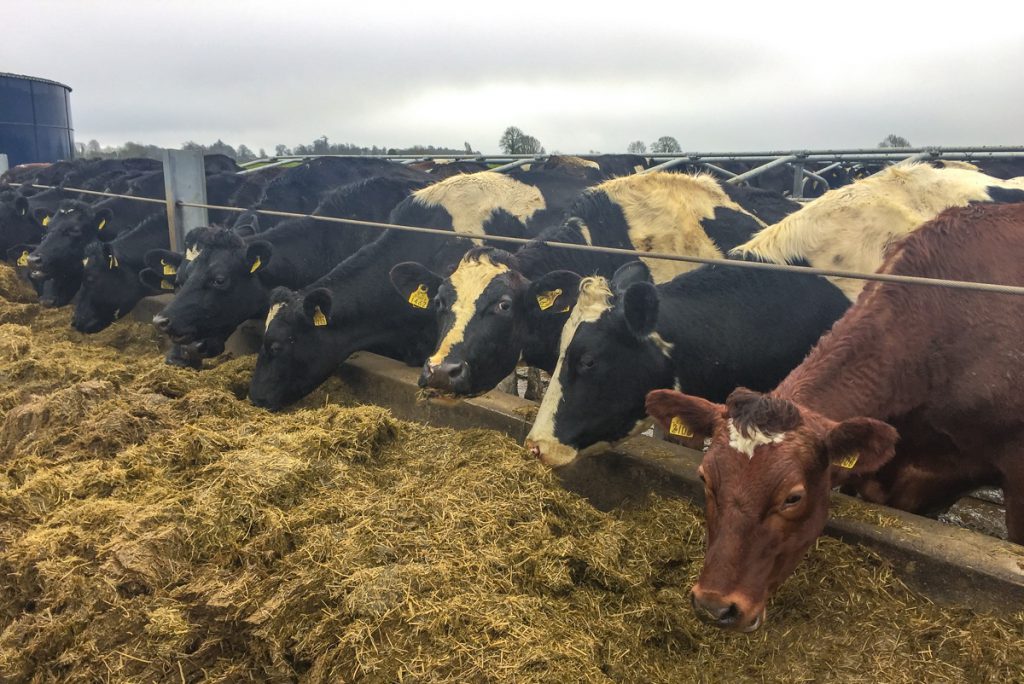Dairy farming in Co. Meath, Mark Cassidy is using the downtime between drying off and calving to prepare for next spring.
With calving set to begin in early February, it’s going to be an extremely busy period on the farm; more than 90% of his kiwi-cross herd are expected to calve in just six weeks and, at its peak, more than 20 cows will calve per day.
AgriLand recently visited Mark’s farm to find out how preparations are going and what steps he takes to reduce stress during the peak workload period on the farm.
The idea of calving 90% of the herd in six weeks is quite daunting, but it’s all about being well prepared to cope with the tsunami of calves that’s ahead.
“The first six weeks of calving are pretty hectic. I refer to it as a tsunami because you are sitting there in January and you know it’s coming and there’s nothing you can do to slow it down,” he said.
Mark’s farming mentality is to save time in every possible way. He said: “We can all make more money, but we can’t make more time.”
To ease some of the pressures associated with calving a large herd of cows in a short space of time, he sets a solid plan. This focuses on four key areas, including: animals; facilities; people; and personal health.
1. Animals
To ease the springtime burden, all of the bull and beef heifer calves are sold off the farm as soon as possible. Also, the replacement heifer calves are moved to an out farm and do not return to the milking herd until two months prior to calving.
“All of the cows are vaccinated for scour in January and newborn calves are moved shortly after birth. At moving, they’re stomach tubed with 4L of colostrum, their navels are disinfected and they’re tagged.
I place a huge emphasis on having healthy stock, so this routine is practised religiously and, for the most part, it’s carried out by me.
“It’s important that all calves remain healthy, as we don’t have the space or time to build up calf numbers. Everyone must disinfect before entering the calf shed and access to this area is very much restricted.
“Nobody from outside of the farm is allowed pass through the door of the calf shed ever. This is especially the case for calf buyers and vets; it’s just not worth the risk of allowing a disease to enter.”
The Meath-based farmer also gives careful consideration to the nutrition of his cows, adding: “The biggest stress point that you will ever have during the calving season is health problems in cows.
To limit this, I avoid having thin cows at drying off by feeding a high-energy and low-protein ration for at least a month prior to drying off.
“Dry cows are fed according to their body condition score (BCS) in December and thin cows are separated and managed to achieve a BCS of 3.25 at calving.
“Minerals are also fed to counteract any deficiency in the silage and iodine is added to the water for dry cows and in-calf heifers.”
2. Facilities
Although Mark admitted that the facilities on the farm are pretty basis, he focuses on making sure that everything is fit for purpose – whether that’s gates hung properly or working lights – before the start of calving.
“We have to do the best we can with what we’ve got, so it’s important to make sure that your yard is as well set up as possible for next spring.
“If you think the facilities are perfect on your farm, just ask those that work on your farm what they’d change. They’ve a fresh pair of eyes and you might be surprised with the answers you get.”
Prior to calving, the cows are held on a wood chip pad. This also doubles as a silage pit during the early months of the winter. A shed containing 10 calving pens is also present on the farm and this backs on to the calf shed.
“The cows go on to the pad one week before calving. Afterwards, they’re moved to a transition herd for four days; this herd is given access to grass by day.
“Following this period in the transition herd, they’re moved into the milking herd and are out at grass both day and night.”
In the calf shed, calves are batch fed whole milk, which is pumped directly from the parlour using a metered nozzle.
The calf shed isn’t bedded and the calves are kept on timber slats to reduce the workload associated with bedding. Replacement heifers are gone within a few days and the other calves go to the mart as soon as possible.
One of the key labour-saving features used in the calf shed is a trap door. This door links the calving and calf sheds together and eliminates the need to move a newborn calf out in to the yard.
3. People
Mark utilises the services of contractors and the Farm Relief Service to ease the springtime burden.
“I’ve a team of six people, including myself, that work on the farm during the busy calving season, which runs from early February until March 17.
“In January, I’m planning a workers’ meeting to discuss all of the roles and procedures so that everybody knows their job well in advance of calving.
I don’t have people in for more than two-to-three days in a row. All workers are part-time and work through the Farm Relief Service. They’re roistered to suit their other commitments, such as work, kids and study.
On the schedule for next spring, he said: “During the first month, we milk once a day and there’s always two people in the milking parlour.
“Their role is to milk, draft out and manage the freshly-calved cows. These two people are roistered from a team of three.”
Another step taken to reduce the pressure on the farm is that no freshly-calved cows are milked in the evening. “There’s always enough colostrum from the morning milking available,” he said.
When it comes to managing calves, he said: “One person feeds all of the calves in the spring and they’re roistered from a team of two people.
Grass and newborn calf management are my main roles during the springtime and I ensure that all calves get sufficient colostrum, are tagged, disinfected and are moved into the calf shed.
Next spring, Mark hopes to have a separate team of two or three people to cover weekend milkings. This, he said, will give the weekday team a “deserved break”. In addition, a night calver will also be employed to release Mark from the farm for two or three nights each week.
Working with people
The Meath-based dairy farmer also highlighted the importance of having a standard operating procedure available for all of the major roles on the farm.
“Every task on the farm has a procedure attached to it. I have procedure sheets laminated and stuck on the walls so – if anyone is unsure of anything – they can revert back to the procedure sheet and they don’t need to phone me.
“These procedure sheets are essential to allow me to step back and it means that everyone knows exactly what is required.
“Getting the message across can be challenging. However, I’ve found that if it’s clearly explained in black and white, it’s much easier to get the message across,” he said.
4. Personal health
Despite being well prepared, Mark admitted that the calving season is a very physically demanding time in the year. In anticipation of this, he begins fitness training.
“Stress can also have a very negative impact on your mental health and I actively plan for stress by being prepared. I look back the previous year’s calving stress points and I put a plan in place to prevent them happening again.
“I also use a checklist to keep track of on-farm preparations, which begin in December. And, when a job is completed, I tick it off the list and focus on another task.
“I find the check list to be a great motivator – especially around Christmas. Once it’s completed, I can be confident that I will have everything ready for the calving season.”
Along with being prepared, Mark also touched on the important role the team around him plays. He said: “I have a vital support team at hand to support the work we do with the animals.
“I’ve a very good relationship with my contractor and maintaining that is key to the business, as all of the machinery work is contracted out. A calf seller also takes the calves to the mart every Monday morning throughout the spring.”








